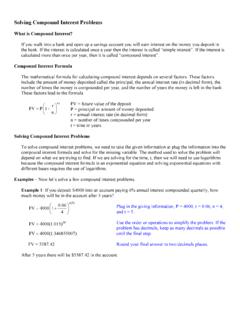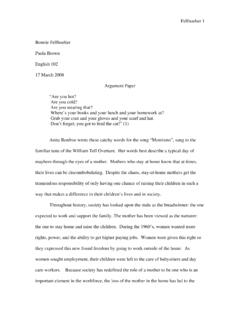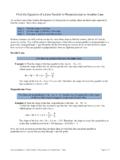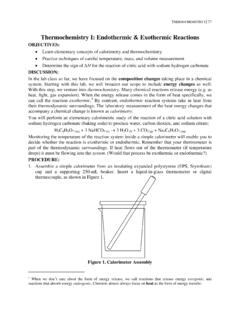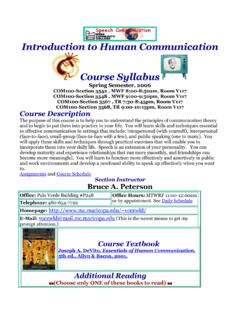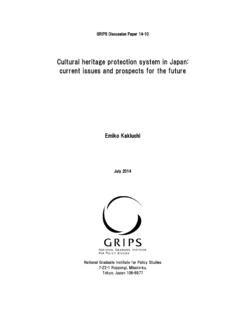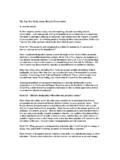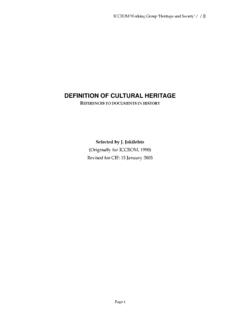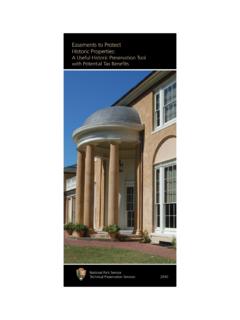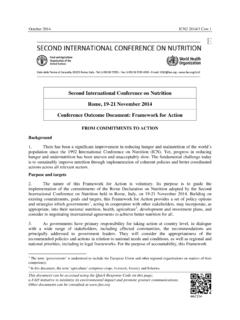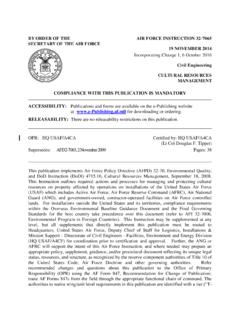Transcription of Cultural Preservation and Protection
1 Cultural Preservation and Protection By Elizabeth A. Thomas-Hoffman For generations, the weavers of Africa have perfected the art of making blankets and cloth in complicated patterns and vibrant colors. Traditionally in Africa, weavers produce luxury fabrics for religious ceremonies, weddings and for chiefs and kings to wear. Afel Aly Sarre is one of the gifted weavers of this traditional fabric. Afel finds it hard to keep his art and his culture alive, however. Imported cloth and clothing and the urbanization of many rural areas of Africa is grinding away at the traditional Cultural aspects of life in some African countries (UN Works, 2003).
2 Cultural identity is essential for the peaceful cooperation of civilizations. If people have a strong sense of self-identity through culture, they are more likely to interact peacefully with other cultures, with respect for the diversity of value systems and religious beliefs as well as the tangible aspects of culture. As different cultures become more intertwined, these Cultural identities may change. The fluid nature of culture can be positive, leading to stronger societal structures and values, but also can destroy minority or less-powerful cultures, leading to the disintegration of fundamental human values.
3 One prominent example of the destruction of culture is the destruction of ancient Buddhist statutes in Taliban-ruled Afghanistan. However, threats to culture are evident in all countries, whether countries are developed or developing, or self-governed or ruled by force. North American Native Peoples struggle to maintain their language, art and religious practices and many Native North American children are losing their Cultural identity as they join the socio-economic structure of the dominant culture.
4 In all parts of the global community, diverse peoples struggle to maintain their Cultural identity in the face of globalization, development, conflict and cooperation with the international community. Background Protecting and preserving culture includes aspects of human rights, tolerance, development and protecting Cultural sites and artifacts, as well as intellectual property rights for culturally specific language and art. The Protection and Preservation of the diverse cultures of the world is one of the foundations on which the United Nations was built.
5 The United Nations Education Scientific and Cultural Organization (UNESCO) is the primary body of the UN to protect and preserve culture. At the core of UNESCO's work is the acknowledgement of the links between culture and the broader aims of people throughout the world. Respect, tolerance and Protection of culture are central to the UNESCO mandate of "advancing, through the educational, scientific and Cultural relations of the peoples of the world, the objectives of peace and the common welfare of mankind (UNESCO Constitution, 1945).
6 The International Covenant on Economic, Social and Cultural Rights, adopted by the General Assembly on 16 December 1966 and entered into force 3 January 1976, outlines the rights of self-determination of all peoples to freely pursue their Cultural development (GA, 1976). The 1966 Declaration of the Principles of International Cultural Co-operation states that "each culture has a dignity and value which must be respected and preserved" and that "every people has the right and duty to develop its culture" (UNESCO, 1966, Article 1).
7 The United Nations proclaimed 1995 the International Year for Tolerance, stating the UN is Convinced that tolerance the recognition and appreciation of others, the ability to live together with and to listen to others is the sound foundation of any civil society and of peace (GA, 1993). Numerous other resolutions and declarations of the United Nations promote the Protection and Preservation of Cultural rights, including the Declaration on the Elimination of All Forms of Intolerance Based on Religion or Belief (GA, 1981), the Declaration on the Rights of Persons Belonging to National or Ethnic, Religious and Linguistic Minorities (GA, 1992), the UNESCO Declaration on Race and Racial Prejudice (UNESCO, 1978)
8 And the Convention Concerning the Protection of the World Cultural and Natural Heritage (UNESCO, 1972). Defining Culture Often, people define culture only as it relates to the art and heritage of Native or Indigenous People. However, culture has greater meaning and should be applied to both dominant and minority populations in both developed and developing countries. At the World Conference on Cultural Policies in Mexico City (1982), participants defined culture as the whole complex of distinctive spiritual, material, intellectual and emotional features that characterize a society or social group.
9 It includes not only arts and letters, but also modes of life, the fundamental rights of the human being, value systems, traditions and beliefs." (UNESCO, 1982) This broad definition of culture extends beyond art and heritage, and recognizes the intricate tapestry of culture that defines societies. Culture and Human Rights Most of the international community recognized that there are universal human rights, as set forth in the Universal Declaration of Human Rights (GA, 1948). However, the international community is increasingly sensitive to Cultural relativism, the notion that human values vary with different Cultural perspectives (Ayton-Shenker, 1995, 1).
10 While it is generally recognized that the international community must continually work towards the establishment and Protection of universal human rights, the need to incorporate the myriad Cultural values into the human rights structure is still in its infancy. Regardless of the work yet to be accomplished, the respect for Cultural diversity that leads to Cultural Preservation and Protection has long been a central tenet of the work of the United Nations, grounded in the principles set forth in the International Covenant on Economic, Social and Cultural Rights (GA, 1966), and perpetuated through succeeding covenants, declarations and resolutions of the United Nations.

